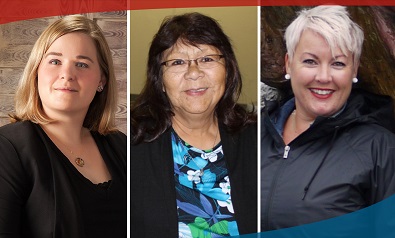Elder Florence Highway, centre, is among the three women quoted as they share their personal stories in the Canadian Diabetes Association report.
An annual report on diabetes in Saskatchewan is putting pressure on the provincial government to pay more attention to Indigenous people.
Currently, 97,000 people in Saskatchewan are diagnosed with diabetes, and the Canadian Diabetes Association estimates that number will jump by more than 35,000 by 2026.
The high prevalence of diabetes in young Indigenous people is a factor in that estimation: association spokeswoman Brie Hnetka said they know that 80 per cent of children living on reserve will get diabetes in their lifetime.
“It is really shocking and so, it’s just more important that we get the word out at how at-risk First Nations people are, but also what can be done so that people, perhaps, might be able to prevent or delay the onset of diabetes, but also to be diagnosed early and to be screened often,” which Hnetka said allows management to start early “so that complications don’t become so serious.”
The 2016 Report on Diabetes in Saskatchewan says “the burden of diabetes and associated risk factors, along with the lack of access to essential supports for healthy living for Indigenous communities, demand the Government’s urgent attention, given the large Indigenous representation in this province.”
The report, which was released this week, gets into more detail in the barriers Indigenous people face in effectively preventing and managing diabetes.
High food prices and food insecurity, as well as social determinants of health like inadequate housing and low level of education, play a role.
The report contains a few recommendations targeted at the provincial government, including a recommendation to create a standard for supports for people with diabetes which specifies “supports needed for optimal diabetes management.”
Hnetka says that recommendation, which requests continuous supports for people who are living with diabetes, is the most relevant for the Indigenous population.
“We need more endocrinologists, which are diabetes specialists, diabetes educators and a more coordinated diabetes-based care team,” she said.
“We have so many people that are being diagnosed and they need help with self-management.”
When it comes to financial constraints, the association wants the province to remove the age limit as qualifying criteria for public funding of insulin pumps and supplies for eligible people with Type 1 diabetes.
Two pages of the 26-page report are dedicated to diabetes statistics in First Nations people, but the report also takes a personal approach to the issue.
Cree Elder Florence Highway is one of the three women with diabetes who are featured in the report.
She is originally from Pelican Narrows and has type 2 diabetes. Highway said when she was first diagnosed 24 years ago, she didn’t take it as seriously as she should have.
“It scared me when I finally realized, and was told by the doctor that if I didn’t look after myself that it would lead to a lot more heavy-duty medical problems: as in blindness, as in amputation, as in dialysis, and finally there was not much they could have done. And that really hit home,” she said.
“When I understood how important it is to look after diabetes to be healthy, I had to do something. I had to change the way I was living, I had to change my eating habits.”
Now she volunteers with the association, travelling to remote areas of the province to talk to First Nations people about diabetes prevention and management.
Highway says language is a common issue she faces as she travels – but as a Cree speaking woman she’s able to share important information about diabetes.
